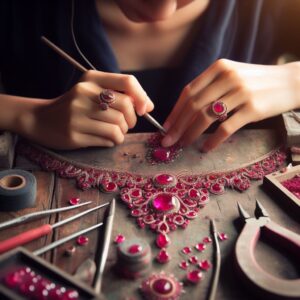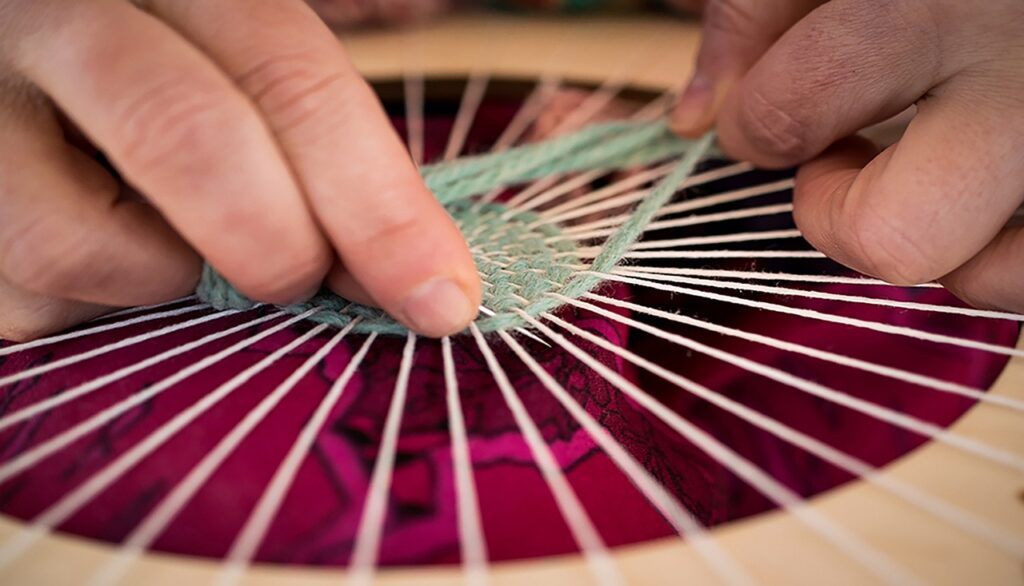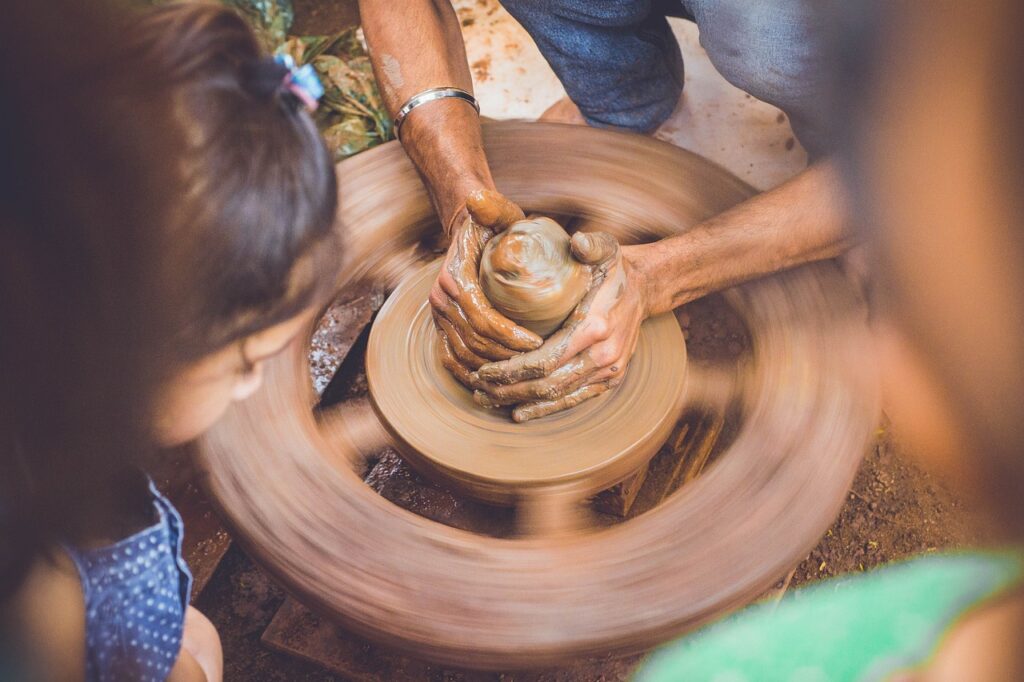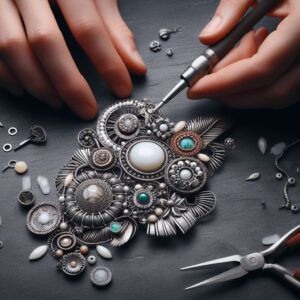
Craftsmanship is the cornerstone of every piece of handmade jewelry, unlocking a world of artistic expression and intricate design. From the meticulous process of selecting the finest materials to the skillful hands that bring these materials to life, each piece tells a unique story of creativity and dedication. Dive into the enchanting realm of handmade jewelry as we unravel the secrets behind the impressive craftsmanship that goes into each exquisite creation.

Materials Used
Precious Metals
When it comes to crafting handmade jewelry, we have a wide array of precious metals at our disposal. From gold to silver and platinum, each metal brings its own unique qualities and characteristics to the final piece. Gold, for example, is known for its durability and resistance to tarnish, making it an excellent choice for creating heirloom pieces. Silver, on the other hand, offers a sleek and elegant look that complements a variety of gemstones and designs. Platinum, with its natural white color and excellent durability, is often used in more intricate and detailed designs. By carefully selecting the right metals for each project, we ensure that our handmade jewelry not only looks beautiful but also stands the test of time.
Gemstones
No piece of handmade jewelry would be complete without the inclusion of stunning gemstones. Whether it’s a vibrant ruby, a sparkling diamond, or a mystical opal, gemstones add a touch of enchantment and personalization to each creation. We carefully source our gemstones from trusted suppliers, ensuring that they meet our high standards of quality and authenticity. From selecting the perfect color and cut to pairing them with the right metal and design, every step of the gemstone selection process is done with utmost care and attention to detail.
Beads and Charms
In addition to precious metals and gemstones, beads and charms play a crucial role in many of our handmade jewelry creations. From delicate seed beads to intricate charms with meaningful symbols, these elements allow us to infuse our designs with individuality and character. We often handpick beads and charms that reflect the wearer’s personality or represent special moments in their lives. Whether it’s a dainty bracelet adorned with birthstone charms or a statement necklace featuring a mix of colorful beads, these small details add a personal touch to each piece of handmade jewelry.
Design and Inspiration
Initial Concept
Every piece of handmade jewelry starts with a spark of inspiration. It could be a beautiful sunset, a delicate flower, or even a cherished memory. We gather inspiration from the world around us, constantly keeping an eye out for unique patterns, textures, and colors. Once an initial concept is formed, we begin to sketch and refine our ideas.
Sketching and Rendering
Sketching is an essential part of our design process. We put pen to paper and allow our ideas to take shape as we translate them into intricate drawings. These sketches serve as a visual representation of our vision, and they help us fine-tune the details of the design. By using rendering techniques, we bring our sketches to life, adding depth and dimension to our designs. This allows us to visualize the finished piece and make any necessary adjustments before moving forward.
Design Iterations
Design iterations are an important part of the creative process. We constantly evaluate and refine our designs to ensure they meet our standards of craftsmanship and aesthetics. Sometimes, this involves making small tweaks to the overall composition or experimenting with different gemstone placements. Other times, it may mean starting from scratch and exploring entirely new design directions. Through this iterative process, we are able to push our creative boundaries and create truly unique and captivating handmade jewelry.
Metalworking Techniques
Soldering
Soldering is one of the fundamental metalworking techniques we employ in crafting our handmade jewelry. It involves using a torch to heat metal pieces and applying a solder alloy to join them together. With precise control of temperature and the right amount of solder, we create strong and seamless connections between different metal components. This technique allows us to bring our designs to life, ensuring that every element is securely held in place.
Forming and Shaping
Forming and shaping metal is an art in itself. Using various tools and techniques, we transform flat sheets of metal into three-dimensional forms, such as domes, curves, and intricate patterns. From hammering and bending to using mandrels and forming stakes, we carefully manipulate the metal to achieve the desired shape and structure. This process requires precision and attention to detail to ensure that each piece looks and feels beautiful.
Texturing
Texturing is a technique we use to add visual interest and dimension to the surface of our handmade jewelry. By employing different methods, such as hammering, etching, or using specialized tools, we create unique patterns and textures on the metal. These textures not only enhance the aesthetics of the piece but also create captivating light reflections and shadows. Whether it’s a hammered finish for a rustic look or intricate engravings for a more ornate design, texturing adds a layer of depth and personality to our creations.
Stone Setting
Bezel Setting
Bezel setting is a popular stone setting technique we employ in our handmade jewelry. It involves creating a metal rim, or bezel, that securely holds the gemstone in place. By carefully shaping and soldering the bezel, we ensure a snug fit that protects the gemstone from damage while showcasing its beauty. Bezel setting is versatile and can be used with various gemstone shapes, allowing us to create unique and eye-catching designs.
Prong Setting
Prong setting is another commonly used stone setting technique that allows us to highlight the brilliance and sparkle of gemstones. With this technique, we create thin metal prongs that hold the gemstone securely in place while allowing maximum light exposure for optimal brilliance. The number of prongs and their placement depends on the shape and size of the gemstone, ensuring a secure and visually pleasing setting.
Channel Setting
Channel setting is a technique often used when incorporating smaller gemstones into our handmade jewelry. It involves creating a channel between two metal walls and securely setting the gemstones within it. The gemstones are held in place by the metal walls, creating a sleek and uniform look. Channel setting is commonly used in bracelets and wedding bands, where multiple gemstones are aligned in a row for a stunning display of sparkle.

Wirework and Chain Making
Wire Sculpting
Wire sculpting is a technique that allows us to create intricate and delicate designs with wire. Using various gauges of wire and specialized tools, we manipulate the wire into desired shapes, such as loops, curls, and spirals. This technique enables us to add embellishments, decorative elements, and intricate patterns to our handmade jewelry. From dainty wire filigree designs to bold wirework statement pieces, wire sculpting adds a touch of elegance and sophistication to our creations.
Chainmaille
Chainmaille, also known as chainmail or chainmaille weaving, is a centuries-old technique that involves interlinking metal rings to create intricate chains. By carefully weaving and connecting the rings in specific patterns, we are able to form chains of various designs and thicknesses. Chainmaille allows us to create unique necklaces, bracelets, and earrings that are not only visually captivating but also durable and flexible.
Wire Wrapping
Wire wrapping is a technique that combines wirework and stone setting. Using thin wires, we wrap and secure gemstones or beads within intricate wire frameworks. This technique not only showcases the beauty of the gemstones but also adds a handmade and organic feel to our jewelry. Wire wrapping allows us to create one-of-a-kind pieces that highlight the natural shape and character of each gemstone.
Casting and Molding
Wax Carving
Wax carving is a technique used in the casting process of our handmade jewelry. It involves sculpting a design from wax, which is then used to create a mold for the metal casting. By carving and shaping the wax with precision, we can create intricate details and textures that will be replicated in the final metal piece. Wax carving allows us to bring our designs to life in a tangible and malleable form before they undergo the casting process.
Investment Casting
Investment casting, or lost-wax casting, is a widely used technique in jewelry making. It begins with creating a mold by encasing the wax model in a heat-resistant material. Once the mold is ready, it is heated, causing the wax to melt and leave behind a cavity. Molten metal is then poured into the cavity, filling the void and taking the shape of the original wax model. After cooling and solidifying, the mold is broken away to reveal the final metal piece. This technique enables us to create complex and highly detailed designs that may not be achievable through other methods.
Lost-Wax Casting
Lost-wax casting is an ancient technique that has been used for centuries to create intricate metal jewelry. It involves creating a wax model of the desired design, which is then encased in a refractory material. The mold is heated, causing the wax to melt and flow out, leaving behind a cavity. Molten metal is then poured into the cavity, filling the space and taking on the shape of the original wax model. Once the metal has cooled and solidified, the mold is broken away to reveal the beautifully casted piece. Lost-wax casting allows us to create detailed and intricate jewelry pieces with fine details and textures.

Enameling and Granulation
Cloisonné Enameling
Cloisonné enameling is a technique that involves fusing colored glass enamel onto metal. Thin metal wires, called cloisons, are carefully soldered onto the metal surface, creating compartments or cells. The cells are then filled with different colors of enamel and fired in a kiln to achieve a vibrant and durable finish. After the firing process, the enamel is polished to create a smooth and glossy surface. Cloisonné enameling allows us to create intricate, colorful, and eye-catching designs that are reminiscent of miniature works of art.
Champlevé Enameling
Champlevé enameling is another enameling technique that involves creating recessed areas on the metal surface, which are then filled with enamel. A design is etched or engraved onto the metal, creating compartments or depressions that will act as the enamel reservoirs. The enamel is then applied to these recessed areas, fired at high temperatures, and polished to achieve a smooth and glossy finish. Champlevé enameling allows us to create designs with a bold and vibrant look, with the metal acting as a contrasting background to the colorful enamel.
Granulation Techniques
Granulation is a decorative technique that involves fusing tiny spheres of metal onto a metal surface. These spheres, often made from precious metals such as gold or silver, are meticulously arranged and soldered onto the base metal. The piece is then heated, causing the spheres to melt and fuse with the base metal, creating a textured and visually captivating surface. Granulation techniques add depth, dimension, and a touch of luxury to our handmade jewelry, showcasing the meticulous detail and craftsmanship that goes into each creation.
Finishing and Polishing
Filing and Sanding
Filing and sanding are essential steps in the finishing process of our handmade jewelry. We carefully file away any rough edges or imperfections to ensure a smooth and comfortable fit. Sanding is done using progressively finer grits of sandpaper, creating a polished and refined surface. These techniques allow us to achieve a flawless finish that enhances the overall aesthetic of the piece.
Buffing and Polishing
Buffing and polishing are techniques we use to achieve a high shine and luster on our handmade jewelry. By using specialized polishing wheels and compounds, we gently buff the metal surface to remove any scratches or dullness. This process brings out the natural beauty of the metal, creating a mirror-like finish that catches the light and adds a touch of elegance to the piece.
Texturing and Patinas
In addition to high shine finishes, we also incorporate various texturing techniques and patinas to add depth and character to our handmade jewelry. Texturing techniques, such as hammering or etching, create unique patterns and surfaces that give our pieces a distinct look and feel. Patinas, on the other hand, create an aged or oxidized appearance, adding an antique or rustic charm to the metal. These diverse finishing techniques allow us to create versatile and visually captivating jewelry designs.

Applying Surface Decoration
Engravings
Engraving is an age-old technique that we utilize to add intricate patterns, designs, or personalized messages to our handmade jewelry. Using specialized tools, we carefully carve or etch the metal surface, creating detailed and precise lines. Engravings can be subtle or bold, depending on the desired effect, and they add a touch of artistry and individuality to our creations.
Metal Inlays
Metal inlays involve adding contrasting metals, such as gold or silver, to the surface of our handmade jewelry. By carefully fitting and soldering these metals into intricately carved recesses, we create stunning visual contrasts and depth. Metal inlays can be used to highlight specific design elements or create a unique pattern that adds a luxurious and sophisticated touch to the piece.
Wire Embellishments
Wire embellishments are delicate and intricate designs created using carefully bent and shaped wires. By adding these wire elements to our handmade jewelry, we create a sense of movement, elegance, and charm. The wires can be twisted, curled, or woven together to form patterns or motifs that enhance the overall design. Wire embellishments provide a whimsical and eye-catching addition to our handmade jewelry.
Quality Control and Final Touches
Inspection and Measurements
Before our handmade jewelry pieces are deemed complete, we thoroughly inspect each one for quality control. We check for any flaws, such as loose stones, imperfect clasps, or uneven finishes. Measurements are carefully taken to ensure precise sizing, ensuring that the piece fits comfortably and securely. This attention to detail ensures that our customers receive a high-quality and meticulously crafted piece of jewelry.
Adjustments and Resizing
When necessary, we offer adjustments and resizing services to ensure that our handmade jewelry fits perfectly. Whether it’s adjusting the length of a necklace or resizing a ring, we take great care in ensuring that the final piece feels comfortable and looks stunning when worn. We understand that jewelry is meant to be enjoyed and cherished, and we strive to make any necessary adjustments to achieve the perfect fit.
Cleaning and Packaging
Before our handmade jewelry is ready to be presented to our customers, we carefully clean and polish each piece to ensure it looks its best. This final touch removes any fingerprints or smudges, leaving the jewelry in pristine condition. Once cleaned, each piece is carefully packaged in a beautiful box or pouch, ensuring that it arrives to its new owner in style. We take pride in presenting our handmade jewelry with the attention to detail it deserves.
Crafting handmade jewelry is a labor of love, requiring a multitude of skills, techniques, and artistic vision. From selecting the finest materials to employing various metalworking and stone-setting techniques, every step of the process contributes to the creation of a unique and exquisite piece. With a dedication to craftsmanship and an eye for detail, we ensure that every piece of handmade jewelry we create is a work of art that will be cherished for generations to come.


